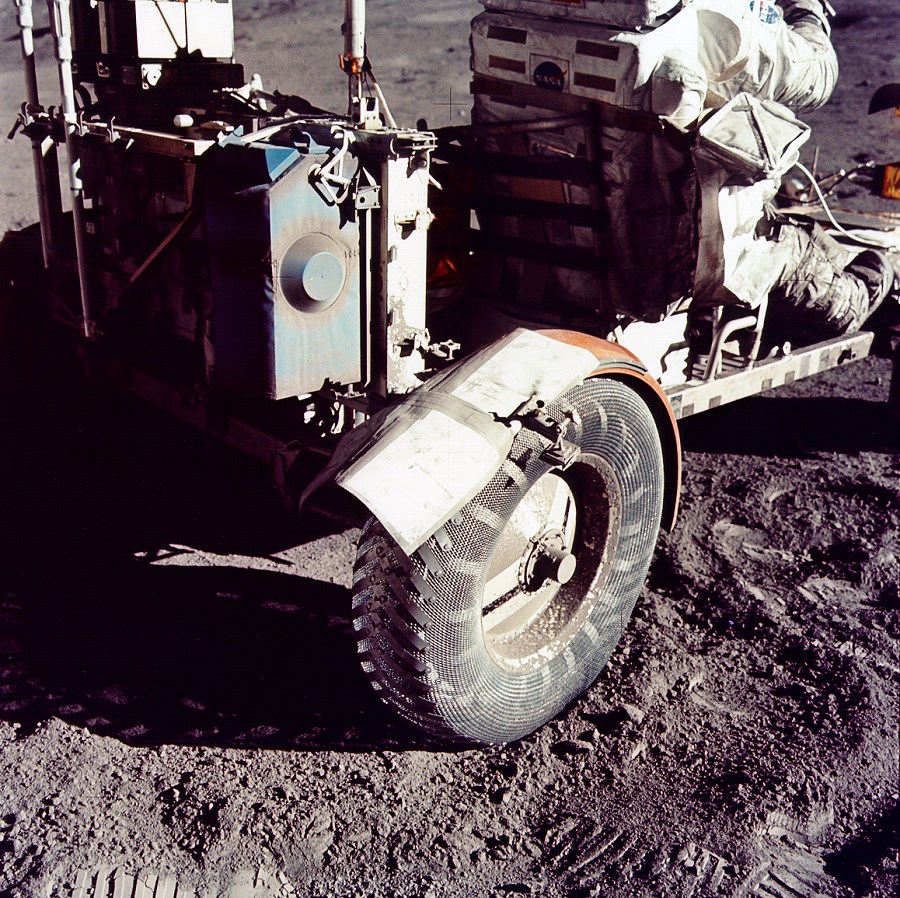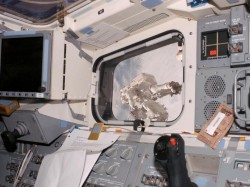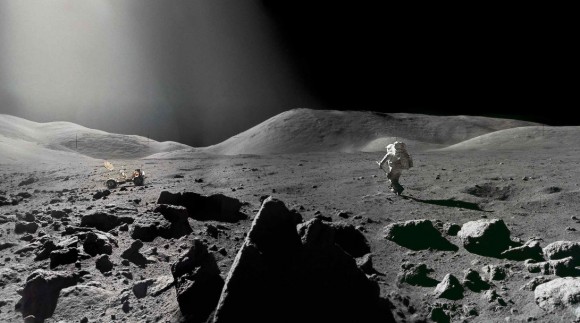The uses for duct tape seem to be endless. From the Apollo missions in the 1970’s to the International Space Station today, duct tape has been used as quick fixes and semi-permanent solutions to a variety of tasks. In a story released today from NASA documenting the events of the Apollo 17 in 1972, duct tape became the saviour of astronauts Gene Cernan and Jack Schmitt as they sped around on the lunar surface in their moonbuggy. Damage to the buggy’s wheel arch could have put the pair at risk and may have curtailed the surface mission (pictured). But with a flash of inspiration and “can do” attitude Cernan and Schmitt found the answer in a roll of grey sticky tape…
It would seem duct tape holds the world together as it is, and it is becoming clear that the tape may hold the frontier of space together too. I recently came across the NASA Astronomy Picture of the Day with a view from the ISS looking over Rick Linnehan as he carried out an EVA during the STS-123 mission in March. As many blogs commented, “wow, even the space station is held together with duct tape!“, duct tape and Velcro did indeed appear to be the best way for astronauts to attach things, fix things and cover up things. In the Great Moonbuggy Race in Huntsville, Alabama, Prof. Paul Shiue of Christian Brothers University even joked that duct tape was his team’s “best engineering tool”. It seems the space station crew agrees with Prof. Shiue as is evident in the photo below.
I think people are surprised that such a common, everyday tool can be utilized in space too, but I’d argue that this kind of versatile and strong tape should be in space doing its bit for space exploration. It seems NASA thinks the same thing. Back in 1972, the use of duct tape turned a potentially dangerous situation into mission success for the Apollo 17 astronauts.
During Gene Cernan and Jack Schmitt’s Moon walk, they employed the use of a moonbuggy to get around the dusty terrain. As is becoming abundantly clear, Moon dust will be one of the biggest challenges to mankind’s efforts on the Earth’s only natural satellite. For starters, this fine Moon “regolith” (dust formed from pulverized rock after countless meteorite impacts) will get everywhere. It is so fine that that it will likely obscure vision and could cause a host of respiratory problems. But the critical issue facing the Apollo astronauts was the dark Moon dust getting stuck to their spacesuits. The moonbuggy was designed to suppress the dust from being kicked up from the surface and spayed over the passengers. Should the spacesuits have a layer of dust over the top, solar electromagnetic radiation would be absorbed very efficiently, causing the astronauts to overheat. At all costs, spacesuits and equipment would need to be “dusted off” to prevent any problems.
Within two hours of the Lunar lander Challenger landing on December 11th, 1972 (at 02:23:35 UTC), Cernan and Schmitt were busy loading the moonbuggy with geology tools and experiments. In a seemingly minor error, the hammer strapped to Cernan’s suited leg caught the buggy’s rear fender and ripped it half off. It may not sound like much; after all who needs a fender on the Moon? But this was a big problem. If they were to use the buggy in this condition, huge plumes of dust would be kicked up (known as “rooster tails”) and showered over the astronauts, sticking to their suits, possibly causing serious overheating issues. Lunar dust is also very abrasive and static, should it get wiped off visors, the glass will get scratched, impeding vision. Joints, latches and hinges would also get severely damaged by the stuff.
Fortunately the astronauts had packed duct tape and were able to do a make-shift job at fixing the fender. Unfortunately the harsh vacuum of space, the continuous exposure to the Sun and the ever present dust caused the tape to lose its “stick”. A more permanent solution was required. After communication with mission control, a solution was found. Using a combination of duct tape and laminated maps, the fender could be reconstructed. The EVA continued and the mission was a success.
See the NASA video of Gene Cernan carrying out duct tape repairs on the Moon »
The Apollo 17 mission is the last time man walked on the Moon, and remains the most extreme place where duct tape was called into use.
For the complete and absorbing story about the duct tape repair job by Gene Cernan, check out the full NASA article…




To Duae:
You’re absolutely right, I should have mentioned Apollo 13 too.
I’m packing a roll of tape now, I’m never leaving home without it 🙂
Cheers, Ian
Duct tape also had a crucial role in the Apollo 13 drama, as an essential part of the jury rigged carbon dioxide scrubber.
Duct tape is like the force. It has a light side, and it has a dark side, and it holds the universe together.
Would a metalized, mylar-like coverall worn over the moon suit provide a solution to the dust problem? The smooth, reflective surface would minimize the surface area that dust could stick to, unlike the warp and weft of the moon suit. The reflective surface would reduce, if not eliminate, the absorption of solar electromagnetic radiation.
Once the astronauts are in the airlock, an electrical cable could be attached to the coverall. As the air pressure comes back up a low voltage, alternating polarity could be shifted back and forth to repel the statically charged dust. An air shower, like those used by technicians prior to entering a clean room area could stir the dust and keep it airborne as a suction fan pulls the suspended dust towards an hepa-filter. A minute or so of this and the astronauts and the airlock could be dust-free.
The handy man’s secret weapon\.
As someone who works in science, we often joke that most of our experiments are ‘held together with string and sticky-tape’.
Seems the space program is no different!
Aviators have long known that duct tape holds the world together! Skydivers call it “120-MPH tape”, and it’s all over most jumpships – not to hold the plane together, but to cover any parts of the plane a jumper might hangup their jumpsuit, equipment, etc. on. And I’ve seen it used, and used it. in a 1000 other ways. Don’t leave home without it…
Actually, duct tape is really The Force. It has a dark side and a light side, and it holds the Universe together.
Oh, I’m sorry Randy that you didn’t appreciate my article. It seems that everyone else thought it was OK; I thought it at least made for an interesting story.
Oh well, can’t please everyone 😐
If you watch NASA TV during shuttle flights you’ll often see the astronauts using duct tape to hold stuff down. I think they keep a few rolls stowed above the windows looking into the cargo bay.
Horrilbe article. It took four paragraphs to get to why duct tape was needed.
So I can hear it now.
A future alien civilization will enter our planetary flock while amateur and professional astronomers all verify its entry and its increasing angular area. Excitement runs through the entire human race as we find out we are not alone.
The aliens circle out planet and send down their first telecommunications: “We are out of duck tape and velcro. Could you guys spare a few rolls?” Please ship them up to the ISS. We’ll pick them up there.”
So they do and then they leave.
Did anyone notice why there is not one inch of tire track in the supposedly moon dust while there are foot prints all around? I’m sure the two astronauts didn’t pick up the rover and set it down on some untrodden dirt just to take this picture!
Too bad Randy is so busy that he can’t appreciate a well presented story of duct tape and its ongoing role in manned space exploration. I hope you did’nt waste too much of his valuable time.
I recall a story (perhaps unfounded) that back in the Gemini era, NASA had spent a lot of money to develop a tape that would withstand the extreme rigors of use in an outer space environment. The tape they engineered did not work; off-the-shelf duct tape did.
Could I point out that it’s DUCK tape, not duct tape. This is a very common mistake. But, whatever we call it, it sure is indispensible!
Isn’t DUCK tape the major brand name; duct is as close to it without getting into trouble.
Besides, mty end of world, it’s called gaffer tape!
If I remember correctly, duct tape was also used in the CO2 filter rig on Apollo 13, saving the astronauts lives. I am suprised you didn’t mention this.
Duct tape has proven to be indespensible in the history of space travel. All of the parts held together by the duct tape were created in clean room envirnoments. http://www.rapwall.com has published a clean room engineering tool that estimates HEPA filtration needs to create clean room classifications. Check it out. Cool Stuff. Lets hope the astronauts doen’t have to rig to many things in the future with Duct tape!
It’s the first time I comment here and I must say you provide us genuine, and quality information for other bloggers! Great job.
p.s. You have a very good template for your blog. Where have you got it from?